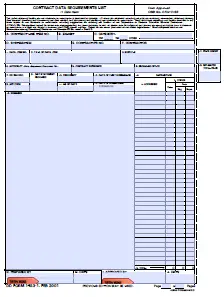The Contract Data Requirements List (CDRL) lists authorized data requirements for a specific procurement that forms part of a contract. It comprises either a single DD Form 1423, or a series of DD Forms 1423 containing data requirements and delivery information. The CDRL is the standard format for identifying potential data requirements in a solicitation and deliverable data requirements in a contract. DFAR Subpart 215.470 requires the use of the CDRL in solicitations when the contract will require the delivery of data.
Definition: The Contract Data Requirement List (CDRL) identifies the specific data requirements (products) that must be delivered by a contractor to the government.
Contract Data Requirements List (CDRL) Form
The Contract Data Requirements List (CDRL) comprises either a single DD Form 1423, or a series of DD Forms 1423. Below is a link to the form.

Form: DD Form 1423 – Contract Data Requirements List (CDRL)
Contract Data Requirements List (CDRL) Purpose
The purpose of the CDRL is to provide a standardized method of clearly and unambiguously delineating the Government’s minimum essential data needs. The CDRL groups all of the data requirements in a single place rather than have them scattered throughout the solicitation or contract.
Contract Data Requirements List (CDRL) Data
CDRLs should be linked directly to Statement of Work (SOW) tasks and managed by the Program Management Office (PMO) data manager. Data requirements can also be identified in the contract via Special Contract Clauses (e.g., Defense Federal Acquisition Regulations Supplement (DFARS)), which define special data provisions (such as Rights in Data, Warranty, etc.). Often the CDRL will include the timing and format required (Data Item Description) for the data deliverables.
Contract Data Requirements List (CDRL) Handbook
MIL-HDBK-245 “Handbook for Preparation of the Statement of Work” states the desired relationship as “Work requirements should be specified in the SOW, and all data requirements for delivery, format, and content should be in the Contract Data Requirements List (CDRL) in conjunction with the appropriate Data Item Description (DID) respectively, with none of the requirements restated in other parts of the contract.”
What is a Data Item Description (DID)
A DID is a completed document that defines the data required of a contractor and is included in a CDRL. The document specifically defines the data content, format, and intended use. The CDRL process allows for tailoring, defined as identifying which part of a DID does not apply to the specific acquisition and may explain how the DID will be applied without otherwise altering the DID. The CDRL form provides a block for simple citation of which DID it is, as well as which points in the Statement of Work it is mentioned and what part(s) of the overall Work Breakdown Structure it is involved with.
Standard DIDs for all topics can be found in the ASSIST Database by entering their 5-digit DID number or searching for them by inputting “DI” into ASSIST – Quick Search.
Contract Data Requirements List (CDRL) Examples
The DoD Cost Assessment and Data Enterprise (CADE) have developed a list of example CDRL packages for a variety of different data types. Below is a few examples of CDRLs:
- Example CDRL Contractor Business Data
- Example CDRL Cost Data Summary Report
- Example CDRL Technical Data Report
- Example CDRL Functional Cost Hour Report
- Example CDRL Software Development Report
- Website: DoD CADE Example CDRL
Difference between SDRL and CDRL
Subcontract Data Requirements List (SDRL) is a flow-down of CDRL requirements from a prime contractor to a subcontractor. Typically, the prime will organize the SDRL to ensure that subcontractor data submissions align with the technical content, timetable, and other aspects of the prime contract CDRL.
Lessons Learned in Developing a Contract Data Requirements List (CDRL)
Putting together a list of data requirements for an executable contract can be a complicated process. Here are some things you might want to remember:
- Start by making it clear what your project is all about. This will help you figure out which parts of the data you need for your contract and which ones you don’t.
- Think about what everyone involved in the contract needs. This includes the people who signed the contract and anyone else who may be affected by it (e.g., regulators).
- Use a standard format for your list of information needs. This will make it easier for everyone to understand the information and figure out what it means.
- Make sure your list of data requirements is full and correct. This will help keep misunderstandings and disagreements from happening in the future.
- Check your data requirements list to ensure it works well and quickly. This could mean working with a small group of users to get feedback and determine the problems.
- Keep your data requirements list up to date. As your business’s needs change, you might need to add to or change the data elements on your list.
- Share your list of data needs with everyone involved in a clear way. This will help make sure that everyone understands the contract and that it is carried out without problems.
AcqNotes Tutorial
AcqLinks and References:
- DD Form 1423 – Contract Data Requirements List (CDRL)
- MIL-HDBK-245 “Handbook for Preparation of the Statement of Work”
- Contract Data Requirements List (CDRL) Best Practices by Craig Bergquist
- Example: Contract Data Requirements List
- Website: ASSIST – Quick Search
- Website: DoD CADE Example CDRL
Updated: 2/3/2024
Rank: G1.1
